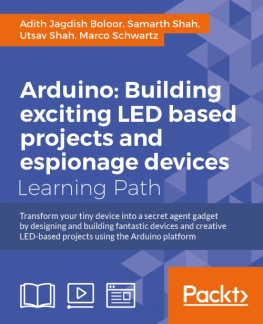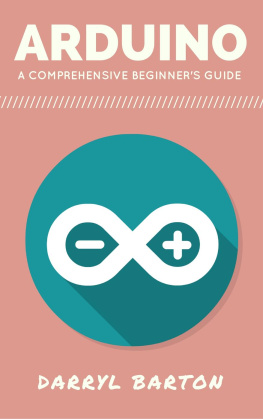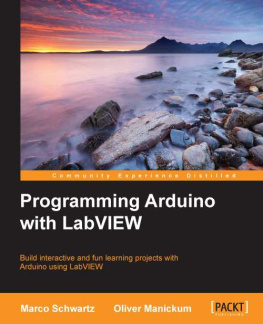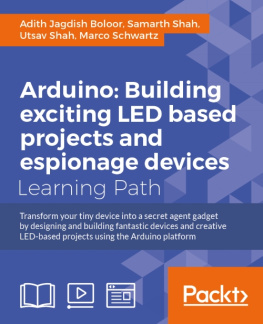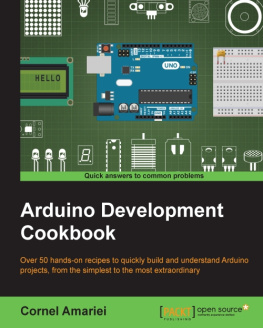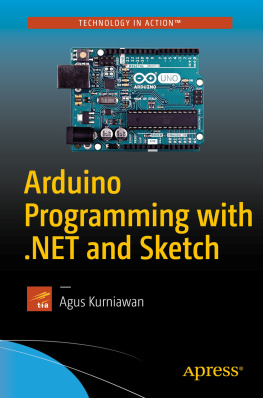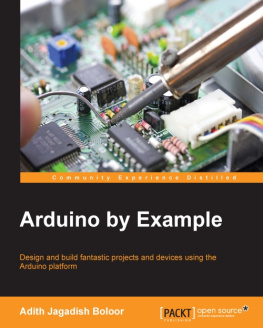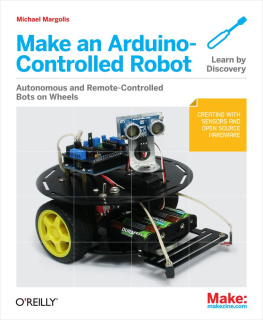Adith Jagdish Boloor - Arduino: Building LED and Espionage Projects
Here you can read online Adith Jagdish Boloor - Arduino: Building LED and Espionage Projects full text of the book (entire story) in english for free. Download pdf and epub, get meaning, cover and reviews about this ebook. year: 2016, publisher: Packt Publishing, genre: Computer. Description of the work, (preface) as well as reviews are available. Best literature library LitArk.com created for fans of good reading and offers a wide selection of genres:
Romance novel
Science fiction
Adventure
Detective
Science
History
Home and family
Prose
Art
Politics
Computer
Non-fiction
Religion
Business
Children
Humor
Choose a favorite category and find really read worthwhile books. Enjoy immersion in the world of imagination, feel the emotions of the characters or learn something new for yourself, make an fascinating discovery.
- Book:Arduino: Building LED and Espionage Projects
- Author:
- Publisher:Packt Publishing
- Genre:
- Year:2016
- Rating:4 / 5
- Favourites:Add to favourites
- Your mark:
Arduino: Building LED and Espionage Projects: summary, description and annotation
We offer to read an annotation, description, summary or preface (depends on what the author of the book "Arduino: Building LED and Espionage Projects" wrote himself). If you haven't found the necessary information about the book — write in the comments, we will try to find it.
Find out how to transform your Arduino device into an awesome secret agent gadget with this course, taking in everything from robotics to remote control cameras
About This Book- This course wont just teach you. It will help you apply your knowledge so you can get creative quickly!
- Find out how to make a computer interact with the real-world youll be learning the basics of IoT without realizing it.
- Robots. A sound controlled Christmas tree. This course proves anything is possible with an Arduino!
Seeking inspiration? This course will help you get creative with your Arduino quickly.
What You Will Learn- Find out how to explore the full potential of your tiny Arduino
- Find out how to bridge the gap between the real world and software, as you gather and visualize data from the environment
- Create simple servers to allow communication to occur
- Transform your Arduino into a GPS tracker
- Use the Arduino to monitor top secret data
- Build a complete spy robot!
An Arduino might be a tiny computer but it can be used as the foundation for a huge range of projects. In this course, well show you how just some of the projects that are possible with an Arduino. From robotics to secret agent gadgets, were pretty confident that this course will get you thinking creatively and inspire you to create your very own new projects using the Arduino hacking skills you learn.
This course, combines both text and video content its made up of three modules to help organize your learning. In the first module well show you how to build three different Arduino projects. All of these will not only get you up and running with something practical, theyll also help you better understand how the Arduino works. Find out how to develop a home automation system and even build a robot!
In the second module well go one step further to help you get creative as you learn how to program LEDs with your Arduino. Youll find out how to build a mood lamp and a remote-controlled TV backlight, before going on to make a sound controlled LED Christmas tree that makes use of sound visualization.
Finally, the third module takes you from stylish design into espionage, as you learn how to create neat secret agent gadgets with your Arduino. Find out how to build an alarm system, a fingerprint sensor, even open a lock with a text message. And thats not all but to find out more youll have to dive in!
This Learning Path combines some of the best that Packt has to offer in one complete, curated package. It includes content from the following Packt products:
- Arduino By Example by Adith Jagadish Boloor
- Arduino BLINK Blueprints by Samarth Shah, Utsav Shah
- Arduino for Secret Agents by Marco Shwartz
Combining both video and text and built from some of Packts very best Arduino content, this course comprises of three modules covering a range of projects. Its completely focused on helping the user get creative as quickly as possible so they can explore whats possible with Arduino themselves.
Adith Jagdish Boloor: author's other books
Who wrote Arduino: Building LED and Espionage Projects? Find out the surname, the name of the author of the book and a list of all author's works by series.

